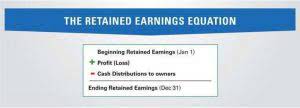
If the revenues come from a secondary activity, they are considered to be nonoperating revenues. For example, interest earned by a manufacturer on its investments is a nonoperating revenue. Interest earned by a bank is considered to be part of operating revenues. Liabilities often have the word “payable” in the account title.
What role do debits and credits play in accounting transactions?
If the customer purchased on credit, a sales allowance will involve a debit to Sales Allowances and a credit to Accounts Receivable. A balance on the right side (credit side) of an account in retained earnings the general ledger. The abbreviation of the accounting and bookkeeping term credit. The accounting term that means an entry will be made on the left side of an account.
- Under the accrual basis of accounting, the Service Revenues account reports the fees earned by a company during the time period indicated in the heading of the income statement.
- It also helps meet rules set by the International Accounting Standards Board (IASB) and the IRS.
- This means that when you make a credit entry to one of these accounts, it increases the account balance.
- Asset, liability, and most owner/stockholder equity accounts are referred to as permanent accounts (or real accounts).
- Companies increase revenues and/or reduce expenses in order to increase profits and earnings per share (EPS) for their shareholders.
Magnificent Adjusted Trial Balance

It allows for proper classification of transactions and ensures that financial statements reflect the true financial standing of the entity. By starting each year with zero balances, the income statement accounts will be accumulating and reporting only the company’s revenues, expenses, gains, and losses occurring during the new year. In other words, the permanent accounts are the accounts used to record and store a company’s amounts from transactions involving assets, liabilities, and owner’s (stockholders’) equity. As we can see from this expanded accounting equation, Assets accounts increase on the debit side and decrease on the credit side.
How to Analyze Accounting Transactions, Part One
For example, when a business purchases equipment, the equipment asset account is debited, reflecting an increase in assets. Conversely, when a business takes out a loan, the loan liability account is credited, signifying an increase in liabilities. Adherence to these norms is not merely a matter of convention but a functional necessity for the clarity and accuracy of financial data. To maintain the balance sheet equation, which states that the assets must equal liabilities plus equity, every transaction must be recorded with proper debits and credits.
- Normal balance is a fundamental concept in accounting that determines the expected side or category where an account balance should appear.
- For example, suppose a company buys equipment on credit for $10,000.
- Accurate bookkeeping is the backbone of financial health for any business, ensuring that every transaction is properly recorded and accounted for.
- The account’s net balance is the difference between the total of the debits and the total of the credits.
- Next to the debit and credit columns is usually a “balance” column.
Difference Between Banking and Accounting Perspectives

Conversely, any adjustments or returns Record Keeping for Small Business that reduce revenue are recorded as debits. The accurate recording of revenues is essential for assessing the company’s performance and profitability over a period. Remember that credits increase equity, liability, or revenue accounts while decreasing expense or asset accounts. Therefore, since revenues cause owner’s equity to increase, it is credited and not debited.
- The chart of accounts can be expanded and tailored to reflect the operations of the company.
- The same thing happens when we record revenue earned on the account; we credit the Sales Revenue account (its normal credit balance), and we debit Accounts Receivable.
- Hence, these accounts are also known as general ledger accounts.
- This method ensures that financial statements accurately represent the company’s actual earnings and outstanding obligations under GAAP.

The bottom line is revenue is not posted as a debit but as a credit because it represents a company’s income during an accounting period and this income has an impact on the company’s equity. The fact is the increase in income and equity accounts is a credit, so revenues will definitely also be a credit entry. The analysis also extends to the examination of internal consistency within the financial records. This involves ensuring that related accounts move in tandem as expected. For instance, an increase in inventory should correspond with a decrease in cash or an increase in accounts payable, depending on whether the purchase was made in cash or on credit. Accountants look for patterns and relationships between accounts to confirm that the recorded transactions make logical sense within the context of the business’s operations.
What Is Normal Balance In Accounting

A gain is measured by the proceeds from the sale minus the amount shown on the company’s books. Since the gain is outside of the main activity of a business, it is reported as a nonoperating or other revenue on the company’s income statement. But, prepayments are liabilities because it is not yet earned, and you still owe something to a customer. The deferred revenue turns into earned revenue (which is an asset) only after the customer receives the revenue normal balance good or service. Do customers pay you for your goods or services before you actually deliver them?
- The Small Business Administration (SBA) highlights the importance of checking account classifications.
- Sales revenue is often referred to as simply revenue, sales, or turnover and normally these terms can be used interchangeably and mean the same thing.
- Prepaying insurance, an asset, is debited because it promises future benefits.
- The basic principles of accounting are essential for any individual wanting to analyse financial data or conduct business finances successfully.
- The accumulated depreciation ($75) is taken away from the original cost of the equipment ($3,500) to show the book value of equipment ($3,425).
- He has $30,000 sitting in inventory and buys another 5 computers worth $10,000.
Deferred revenue refers to payments customers give you before you provide them with a good or service. Deferred revenue is common in businesses where customers pay a retainer to guarantee services or prepay for a subscription. Deferred revenue is sometimes called unearned revenue, deferred income, or unearned income. An income statement shows the organization’s financial performance for a given period of time.
Sometimes a debit will increase an account and sometimes it will decrease an account. Likewise, a credit may increase an account or decrease an account. To effectively use double-entry accounting, it is critical that you understand how debits and credits work. However, in double-entry accounting, these terms are used differently than you may be used to. On the income statement, revenue is also known as sales and net income, also known as the bottom line, is revenues minus expenses.

